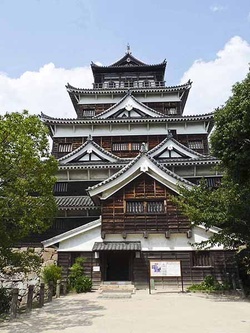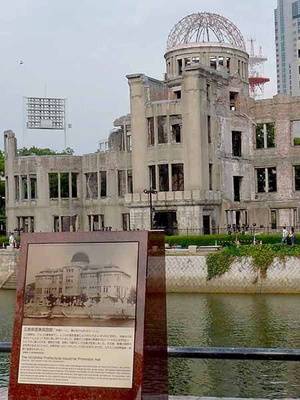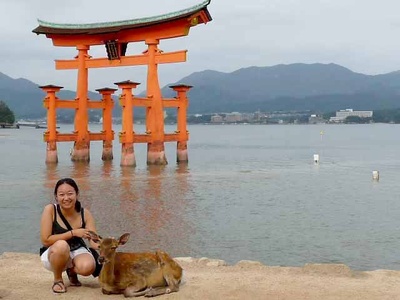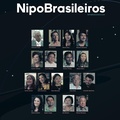Quando cheguei na estação de trem de Hiroshima, senti-me realizada por estar ali. Há muito tempo, guardava a vontade de conhecer essa região histórica e surpreendente do Japão. Hoje, depois de ter conhecido, relembro com admiração e respeito tudo que senti e vi naquele lugar. Claro que Hiroshima já voltou a ser uma cidade desenvolvida, mas o fato de ter passado por uma tragédia caracterizará para sempre o local. Quem ouve falar de Hiroshima, logo se recorda da primeira bomba atômica, apelidada de “Little Boy ”.
O famoso Castelo de Hiroshima foi totalmente destruído pela bomba atirada pelos Estados Unidos. O castelo foi reconstruído em 1958 e é um dos principais pontos turísticos em Hiroshima.
O alvo da bomba era a ponte Aioi, em formato de “T”, que foi então submetida a uma pressão de 7 toneladas por metro quadrado – 15 vezes mais que o normal. Reconstruída, a ponte situa-se a 160 metros do antigo Centro de Promoção Industrial da Prefeitura de Hiroshima. Este prédio agora é chamado por Atomic Bomb Dome ou Genbaku Dome. Foi um dos poucos prédios que sobraram imediatamente após o bombardeio, pois sua arquitetura foi feita já se pensando em casos de terremotos. A estrutura é preservada e protegida pela UNESCO como patrimônio da humanidade em memória da devastação que ocorreu e é um símbolo de esperança de paz mundial e eliminação das armas nucleares do mundo. É emocionante ver pombas e outros pássaros pousando em sua estrutura, ao mesmo tempo em que olhamos os destroços em volta das ruínas.
Espantei-me com a riqueza de informações mantidas no Museu Memorial da Paz de Hiroshima. É possível imaginar com detalhes a tragédia que aconteceu às 08h15m do dia 6 de agosto de 1945, já que o ambiente propicia uma imersão nos fatos da época. Existem vídeos com depoimentos de sobreviventes, cenários simulando a situação da cidade após a bomba, informações sobre bombas atômicas e sobre países que mantêm testes nucleares. Há explicações sobre fatos posteriores à explosão (chuva ácida, sofrimento, doenças genéticas), maquetes da cidade antes e depois da bomba, objetos diversos como garrafas derretidas, fotografias, relógios parados no horário do bombardeio, telhas e outros objetos pessoais.
Durante a visita ao Museu, não é raro ver visitantes enxugando as lágrimas. Após o ataque, os sobreviventes da bomba vagaram pela cidade entre destroços e corpos no chão, sem saber direito o que havia acontecido. Suas peles desprendiam-se, tufos de cabelo caíam e tinham queimaduras graves por todo o corpo. Lembrando que, três dias depois, Nagasaki também sofreu com outra bomba.
No Parque Memorial da Paz, há diversos monumentos apelando pela paz mundial e em homenagem aos falecidos. Um dos mais visitados é o Monumento das Crianças para a Paz, em memória às crianças vítimas da bomba. Ao seu redor, encontram-se dobraduras de pássaros vindas de todas partes do Japão e do mundo, chamadas de tsuru, que remetem à história de Sadako Sasaki, uma menina que sobreviveu à bomba, mas adoeceu após alguns anos por leucemia e morreu, embora tenha acreditado que sobreviveria se conseguisse dobrar mil tsurus . No Parque, também há um sino de mais de uma tonelada, o Sino da Paz, que pode ser tocado pelos visitantes a favor da paz.
No centro do Parque, foi construído um cenotáfio em 1952, como iniciativa de reconstruir Hiroshima como cidade dedicada à paz. Olhando através de seu arco, conseguimos ver no horizonte, as ruínas do A-Bomb Dome e a Chama da Paz, mantida acesa desde 1964 e que permanecerá acesa até que a ameaça de bombas nucleares desapareça completamente da Terra. No arco do monumento, pode-se ler a frase: “Que todas as almas repousem aqui em paz, pois jamais repetiremos este mal. ” Abaixo do arco, uma pedra grande retangular guarda o registro de todas as vítimas diretas ou em consequência da exposição às radiações. No Memorial Hall, é possível consultar os nomes dos falecidos informando os sobrenomes no sistema multimídia.
Assim, Hiroshima é considerada a “cidade da paz”, mas não deixa de ser um lugar com movimento urbano como outra qualquer e atrai muitos turistas e estudiosos do mundo todo, sendo um ótimo pólo cultural.
Depois de ver tantas imagens tristes e de reflexão, vale a pena um passeio por Miyajima, uma ilha em frente à cidade de Hiroshima. A ilha é considerada sagrada e famosa por seu torii , que é um portão de entrada de templos feito de madeira. Ele é vermelho e fica no oceano, portanto apresenta alguns desgastes. Quando a maré está alta, temos a impressão de que ele está flutuando. Quando a maré está baixa, conseguimos chegar mais perto para admirá-lo e tirar fotos do Santuário Itsukushima, que fica em frente e também foi construído sobre a areia.
Neste Santuário estava ocorrendo um casamento às 08h30m da manhã. Pensei comigo: “Puxa, acorda-se cedo no Japão até para festividades”. Quando estava indo embora da ilha, cerca de 13h, reparei como a ilha ficou repleta de turistas. Foi então que entendi o motivo de um casamento tão cedo – evitar o tumulto do turismo.
Na ilha é possível aproximar-se dos veados, que já estão acostumados com os turistas e aproximam-se querendo comida. Chegam até a xeretar as sacolas apoiadas em bancos, enquanto os turistas tiram fotos.
Falando em comidas, um doce típico de Miyajima é o Momiji manju, um bolinho recheado feito em formato de folha da árvore chamada momiji , a mais apreciada no outono, já que nessa época suas cores vão do amarelo a vermelho. É o chamado kouyou .
Em Hiroshima, o prato famoso é o okonomiyaki . Okonomi significa escolha, preferência. Yaki significa grelhado ou frito. Então o nome do prato quer dizer cozinhar aquilo que você gosta, da maneira que você deseja. É um tipo de pizza bem fina com camadas de repolho, bacon , broto de feijão, itens opcionais (lula, polvo, queijo, etc.), macarrão frito, ovo frito e regado com um molho especial. Um tanto calórico, mas imperdível.
Visitar Hiroshima pode ser um tanto desgastante e não muito agradável emocionalmente, mas é uma experiência incrível e ao meu ver, necessária. Faz qualquer turista voltar para sua casa com um conhecimento a mais, com uma reflexão a mais e por que não, com uma lição de superação.
Notes:
1. Cenotáfio é um memorial fúnebre construído para homenagear uma pessoa ou um grupo de pessoas cujos restos mortais estão em outro local ou em local desconhecido.
© 2009 Silvia Lumy Akioka











